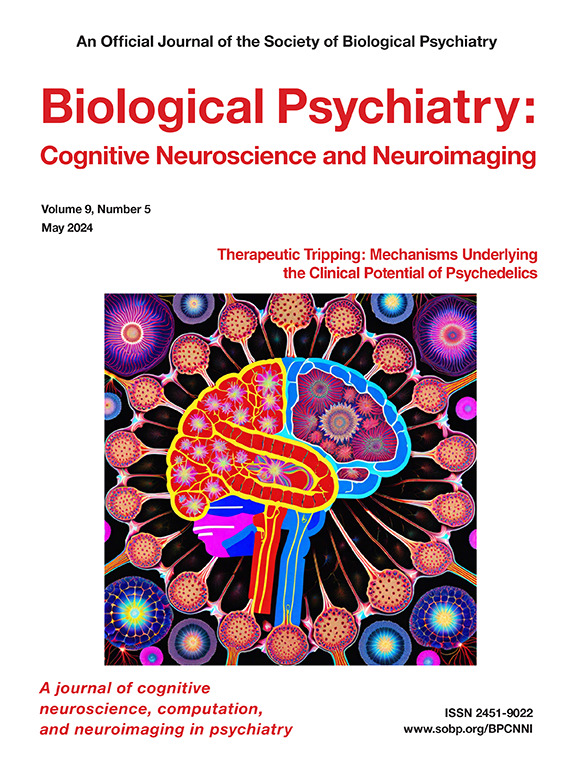暴力暴露和精神症状对儿童和青少年时期杏仁核-前额叶成熟的不同影响
IF 4.8
2区 医学
Q1 NEUROSCIENCES
Biological Psychiatry-Cognitive Neuroscience and Neuroimaging
Pub Date : 2025-05-01
DOI:10.1016/j.bpsc.2024.08.003
引用次数: 0
摘要
背景:童年和青少年时期遭受暴力与精神病理学发病率和严重程度的增加有关。神经生物学相关性表明,与情绪相关的大脑回路(如杏仁核-前额叶皮层(PFC))的异常成熟可能是接触暴力后出现精神症状的基础;然而,杏仁核-前额叶皮层回路的成熟如何与暴力背景下的精神疾病风险相关,目前仍不清楚:本研究利用费城神经发育队列(PNC;N=1,133 名青少年)收集的数据分析了杏仁核-PFC回路成熟度的个体差异。我们利用深度学习建立了杏仁核-PFC静息状态功能连接的神经发育模型,并对其进行了训练,以预测发育正常的青少年(既未接触过暴力,也没有精神病诊断)的实际年龄。利用脑年龄差距估计值(BrainAGE)这一电路相对成熟的指标,对非典型神经发育模式进行了研究:结果:暴力暴露与基底外侧杏仁核(BLA)-前额叶皮质(PFC)回路的延迟成熟有关,而基底外侧杏仁核-内侧眶额皮质的功能连接性增加则是暴力暴露的驱动因素。另一方面,精神症状的增加与基底外侧杏仁核-前额叶皮质功能连接的提前成熟有关,而基底外侧杏仁核-前额叶皮质背外侧功能连接的减少则是其驱动因素:结论:暴露于暴力后前额杏仁核的延迟成熟表明,威胁评估过程的发展是不典型的,但却是适应性的,这可能反映了年幼儿童所特有的更大的威胁泛化。随着症状的增加,神经回路的成熟也会提前,这表明在情绪回路适应逆境后,疾病的神经发育机制存在差异,而之前存在的对早期成熟的脆弱性又会加剧这种差异。厘清逆境和精神病理学对神经发育的影响,对于帮助青少年从暴力中恢复并防止疾病延续到成年期至关重要。本文章由计算机程序翻译,如有差异,请以英文原文为准。
Diverging Effects of Violence Exposure and Psychiatric Symptoms on Amygdala-Prefrontal Maturation During Childhood and Adolescence
Background
Violence exposure during childhood and adolescence is associated with increased prevalence and severity of psychopathology. Neurobiological correlates suggest that abnormal maturation of emotion-related brain circuitry, such as the amygdala-prefrontal cortex (PFC) circuit, may underlie the development of psychiatric symptoms after exposure. However, it remains unclear how amygdala-PFC circuit maturation is related to psychiatric risk in the context of violence.
Methods
In this study, we analyzed individual differences in amygdala-PFC circuit maturity using data collected from the PNC (Philadelphia Neurodevelopmental Cohort) (n = 1133 youths). Neurodevelopment models of amygdala-PFC resting-state functional connectivity were built using deep learning and trained to predict chronological age in typically developing youths (not violence exposed and without a psychiatric diagnosis). Using the brain age gap estimate, an index of relative circuit maturation, patterns of atypical neurodevelopment were investigated.
Results
Violence exposure was associated with delayed maturation of basolateral amygdala (BLA)–PFC circuits, driven by increased BLA–medial orbitofrontal cortex functional connectivity. In contrast, increased psychiatric symptoms were associated with advanced maturation of BLA-PFC functional connectivity, driven by decreased BLA–dorsolateral PFC functional connectivity.
Conclusions
Delayed frontoamygdala maturation after exposure to violence suggests atypical, but adaptive, development of threat appraisal processes, potentially reflecting a greater threat generalization characteristic of younger children. Advanced circuit maturation with increasing symptoms suggests divergent neurodevelopmental mechanisms underlying illness after emotion circuits have adapted to adversity, exacerbated by preexisting vulnerabilities to early maturation. Disentangling the effects of adversity and psychopathology on neurodevelopment is crucial for helping youths recover from violence and preventing illness from continuing into adulthood.
求助全文
通过发布文献求助,成功后即可免费获取论文全文。
去求助
来源期刊

Biological Psychiatry-Cognitive Neuroscience and Neuroimaging
Neuroscience-Biological Psychiatry
CiteScore
10.40
自引率
1.70%
发文量
247
审稿时长
30 days
期刊介绍:
Biological Psychiatry: Cognitive Neuroscience and Neuroimaging is an official journal of the Society for Biological Psychiatry, whose purpose is to promote excellence in scientific research and education in fields that investigate the nature, causes, mechanisms, and treatments of disorders of thought, emotion, or behavior. In accord with this mission, this peer-reviewed, rapid-publication, international journal focuses on studies using the tools and constructs of cognitive neuroscience, including the full range of non-invasive neuroimaging and human extra- and intracranial physiological recording methodologies. It publishes both basic and clinical studies, including those that incorporate genetic data, pharmacological challenges, and computational modeling approaches. The journal publishes novel results of original research which represent an important new lead or significant impact on the field. Reviews and commentaries that focus on topics of current research and interest are also encouraged.
 求助内容:
求助内容: 应助结果提醒方式:
应助结果提醒方式:


